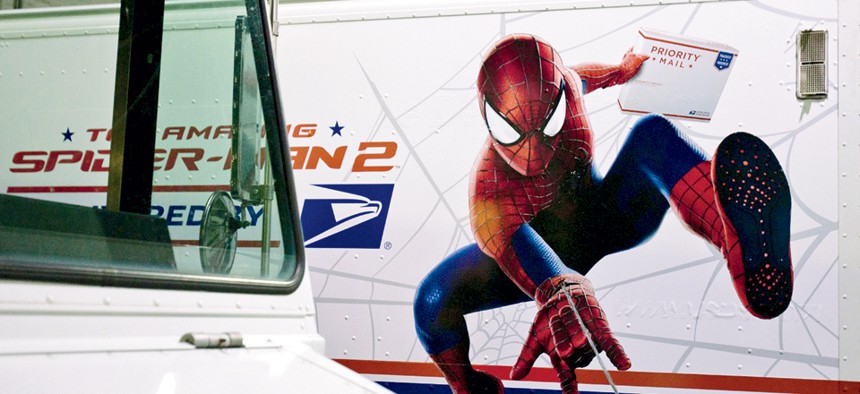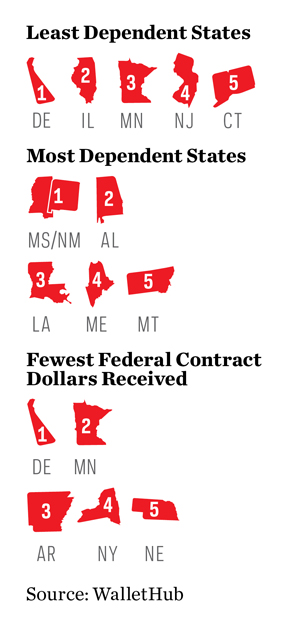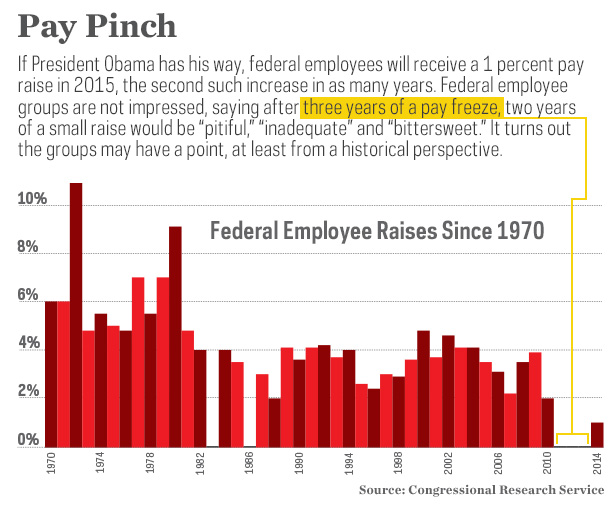
USPS
Around Government
Spidey’s speedy delivery, states and their federal money, weather forecasts months in advance.
Spidey’s Speedy Delivery
The U.S. Postal Service spins a partnership with Spider-Man to pitch Priority Mail.
By Eric Katz
I t’s the old Hollywood trope: While teetering on the edge of disaster, a superhero swoops in at the last possible moment to save the day.
In this case, however, the thing on the edge is not a beautiful woman or a school bus full of children. Some might say it’s a federal agency on the verge of financial ruin.
The U.S. Postal Service has teamed up with Sony Pictures to form a cross-promotional venture, with the agency hoping to sell more stamps and the production studio seeking to boost ticket sales. This spring, USPS launched a TV commercial in which Spider-Man whisks a package amid trying circumstances to movie theater managers, who are in a time crunch to deliver the new release The Amazing Spider-Man 2 to awaiting fans.
“Our Priority Mail products share many qualities with a superhero of Spider-Man’s caliber, namely those of speed, agility and reliability,” says Nagisa Manabe, chief marketing and sales officer at USPS. “Like Spider-Man, our priority has always been the people we serve. We pride ourselves on our commitment to public service and delivering for our customers, and we are excited about enlisting Spider-Man to help promote our priority mail offerings.”
Whether Spider-Man could actually save the Postal Service—an agency that loses millions of dollars every day—is another story entirely.
States of Dependence
The more dependent on the federal government a state is, the less likely it is to impose high taxes on its residents, according to an analysis from WalletHub, the personal finance social network. And perhaps less surprising, wealthy states are much less reliant than economically struggling ones on handouts from Uncle Sam. WalletHub’s Federal Dependency Report found that red states need Washington more than blue states do: The reds had an average dependency rank of 33.5 percent while the blues boasted a 19.2 percent dependency rate. Which state was the least dependent? Delaware. And the most dependent? Mississippi and New Mexico (a tie). States that received the lowest amount of money in federal contracts also tended to be less reliant on Washington.
- Kellie Lunney

Attention, Shoppers
Governmentwide acquisition contracts, the streamlined procurement option that agencies buying information technology have had at their disposal for 20 years, aren’t exactly taking the acquisition world by storm.
“GWACs are not the success we thought they’d be when they started in the early ’90s—they’re only 10 or 15 percent of IT purchases,” says Rob Coen, acting director of the National Institutes of Health’s Information Technology Acquisition and Assessment Center.
Since, 2004, the cross-agency tool has been used in $15.4 billion worth of contracts, including 5,755 task orders in about 10 major contract vehicles, according to the GWAC dashboard compiled by the General Services Administration.
The allure of GWACs, the NIH office notes, is that deals have been “pre-competed and pre-negotiated for below-market pricing, so customers are assured of real value in a competitive IT market.”
Another advantage, Coen says, “is economies of scale.” The biggest “fear among agencies is that they will lose control of the contract,” he told an audience this spring at a conference sponsored by the Homeland Security Department, the General Services Administration and the American Council for Technology-Industry Advisory Council. “But that is not the case because they get to manage the task.”
- Charles Clark
Predicting the Weather Months in Advance
Navy sea bots are trolling more than just the ocean floor.
In the next decade, Navy scientists will be able to predict the weather as far as 90 days into the future with the help of mathematical models, satellites and submarine drones.
That may not sound terribly exciting until you consider that the ability to rapidly update weather predictions helped the allies win perhaps the most famous battle of 1944, when meteorologist Sverre Petterssen demonstrated the feasibility of short-term weather prediction based on the precise collection of weather data. He was instrumental in helping the allies successfully launch the D-Day assault on the beach at Normandy.
“During the World War II D-Day invasion planning, he and other meteorologists convinced Dwight Eisenhower to postpone the operation by one day rather than the proposed 14 days,” says Navy Research Lab scientist Gregg Jacobs. “The acceptance of the one-day delay saved lives.”
Today, the Slocum glider is the most recognizable drone that the Navy and others use in research. These 5-foot-long sea robots collect data on their environment every few seconds and can descend to depths of 4,000 feet. The Navy plans to increase the number of these drones from 65 to 150 by 2015.
Patrick Tucker

Correction: This chart has been updated to reflect the correct pay raises. In the original version, a data point was incorrectly omitted on the percentage axis.
NEXT STORY: Around Government






